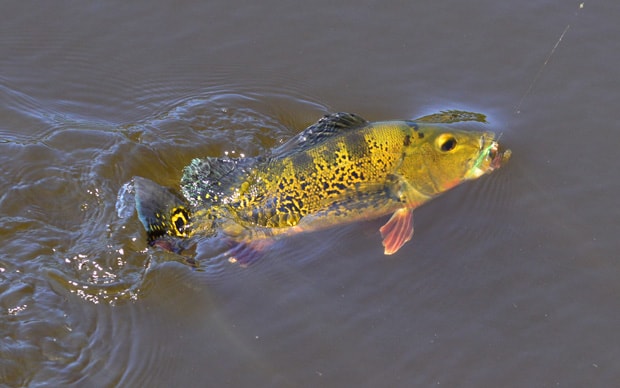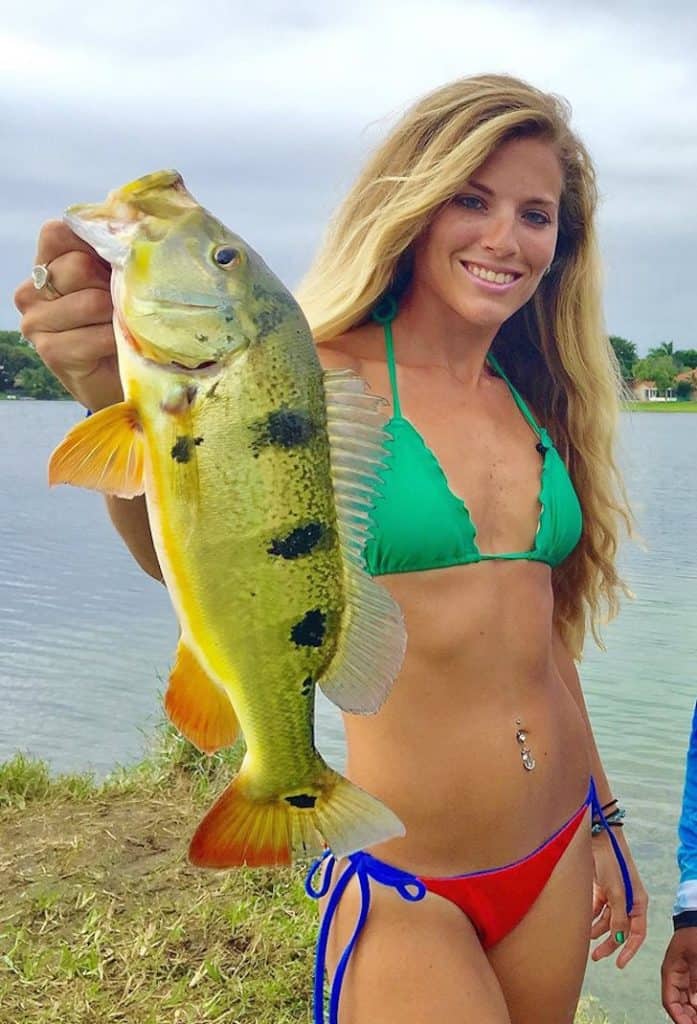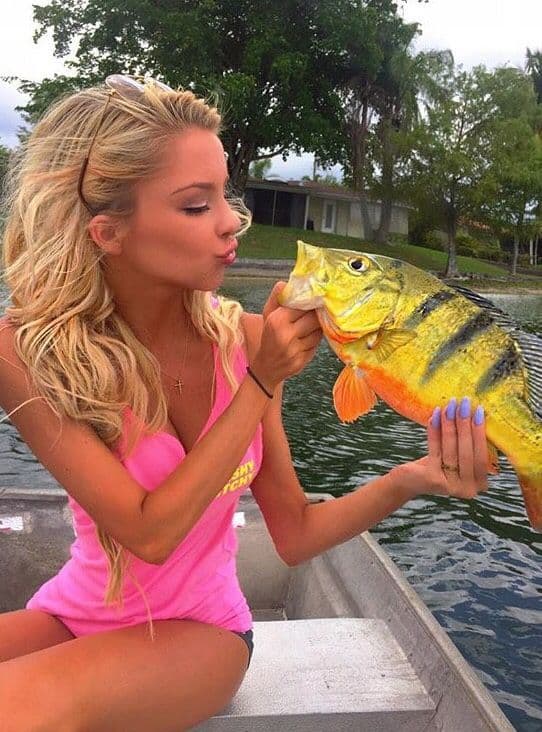Have you ever seen a Peacock Bass before? This is a seriously uniquely awesome species of bass. When you hear the word bass, most think of sparkly boats, baitcasters, and big tournament payouts. But for the fisherman in South Florida, the peacock bass is the staple in the local freshwater systems. With their aggressive eats, strong runs, and beautiful colors, these fish have become prized gamefish. This is what Wikipedia has to say about these beautiful creatures.

Peacock bass (or Brazilian tucunaré) (Cichla) is a genus of large cichlids, diurnal, and predatory freshwater fish native to the Amazon and Orinoco basins, as well as rivers of the Guianas, in tropical South America. They are sometimes referred to in English by their Brazilian name tucunaré or their Spanish name pavon. Despite the common name and their superficial similarity, they are not closely related to other fish known as bass, such as the North American largemouth bass (Micropterus salmoides).
Peacock bass is an important food fish and also considered game fish. This has resulted in their accidental (escapees from fish farms) or deliberate (release by fishers) introduction to regions outside their native range, both elsewhere in South America, and in warm parts of North America and Asia. Singles have been caught elsewhere, including Australia, but do not appear to have become established there. Where established as an introduced species, they may become invasive and damage the ecosystem because of their highly predatory behavior, feeding extensively on smaller native fish.
The largest species in the genus, the speckled peacock bass (C. temensis), reaches up to 13 kg (29 lb) in weight and 1 m (3.3 ft) in length, possibly making it the largest species of cichlid (others suggest that prize goes to the African giant cichlid, Boulengerochromis microlepis). Other peacock bass species are smaller. They are sometimes kept in aquariums, but even the smaller species require a very large tank.
Description Of The Peacock Bass
The butterfly peacock bass is a member of the cichlid and tilapia family. It has a semi-elongate body, largemouth, and a deep notch between the first and second dorsal fins. The body is olive to gold with between three and four black bars on the side. A gold-edged ocellus is present on the caudal fin base but absent in juveniles, and the lateral line is typically continuous, although it can be interrupted. There are between 67 and 82 lateral scales, and the anal fin has three spines. The caudal fin is truncated to slightly rounded. The butterfly peacock bass can be found in large drainage canals, creeks, and lakes.

Where To Find Peacock Bass In The United States
In the continental United States, you have one option: South Florida. The farther south you go, the better. For instance, you won’t find many peacocks in Palm Beach, but you might find a few in Lake Worth, which is a few miles south. Fort Lauderdale and Miami afford even more opportunities.
The reason: Water temperature. Peacocks need warm, tropical temperatures. Eighty degrees is their sweet spot. Anything lower than 60 degrees and they struggle to survive.
Fishing For Peacock Bass
Peacock bass was first introduced to Florida by the Florida Fish & Wildlife Conservation Commission in the mid-1980s to combat the burgeoning population of Oscars, which gorge on juvenile bass. So, in essence, one bass helped another.
The best place to find peacocks is the maze of flood-control canals that cover much of southern Florida. Many are no wider than 40 feet. Most are accessible by foot and are home to baby tarpon, snook, and many exotic species — Oscars, tilapia, and mayans among others.
How To Fish For Peacock Bass Tips
You don’t have to get up at the crack of dawn. In fact, mid-day is often the best time to target peacocks. Look for structure and current. Culverts often produce.
You can blind cast, but I prefer to sight fish. Sight fishing requires stealth and accurate casts. Once the fly has been presented, strip fast. If one hand is not fast enough, try two hands. Check out the video below for how-to tips on fishing for the peacock bass.
Brief History Of The Peacock Bass
Peacock Bass are easily identified by their exotic pattern. According to Florida’s Fish and Wildlife Commission (FWC), this spotted, large cichlid possesses “a yellow-gold halo on the caudal fin.” The caudal fin, also known as the tailfin, is a fish’s primary means of locomotion. When reeling in a green, yellow, and black bass-like creature from South Florida canals, examine the tailfin for a yellow-gold halo around a black spot. If this halo is present, you’ve caught a Peacock Bass!
These fish are non-invasive, but also a non-native species of cichlids. According to the FWC, Peacock Bass are native to the Amazon but were introduced to Florida by the wildlife commission in 1984. Moreover, according to Bassonline.com, Peacock Bass were imported from Brazil, Guyana, and Peru. The fish spawned at the FWC’s Non-Native Fish Research Lab. ”Using three stocks increased genetic variability, and fish were stocked only after being tested by both the U.S. Fish and Wildlife Service and Auburn University to ensure they were disease and parasite free.” Peacock Bass are edible, however, their real value is in “controlling over-abundant exotic forage fish” and providing an exciting catch.

It’s encouraged to practice catch and release fishing while reeling in Peacock Bass, especially for those fish that exceed 14 inches in length. It’s the low water temperature intolerance and intolerance to (brackish) saltwater that prevents this species from becoming prominent.
Live bait is best for attracting the, at times allusive, Peacock Bass. According to Bassonline.com, Peacock Bass are lured in with a variety of tackle and bait: artificial lures, live Shiners, and flies attract this golden haloed fish. These fish bite most readily for live bait and you can increase the level of difficulty by choosing artificial baits. Peacock Bass may be elusive, but the angler who searches South Florida waters is rewarded with one of the World’s most exotic species of large cichlids.
The next time you find yourself in Florida. It could be worth your time to get out and fish for the beautiful peacock bass.

